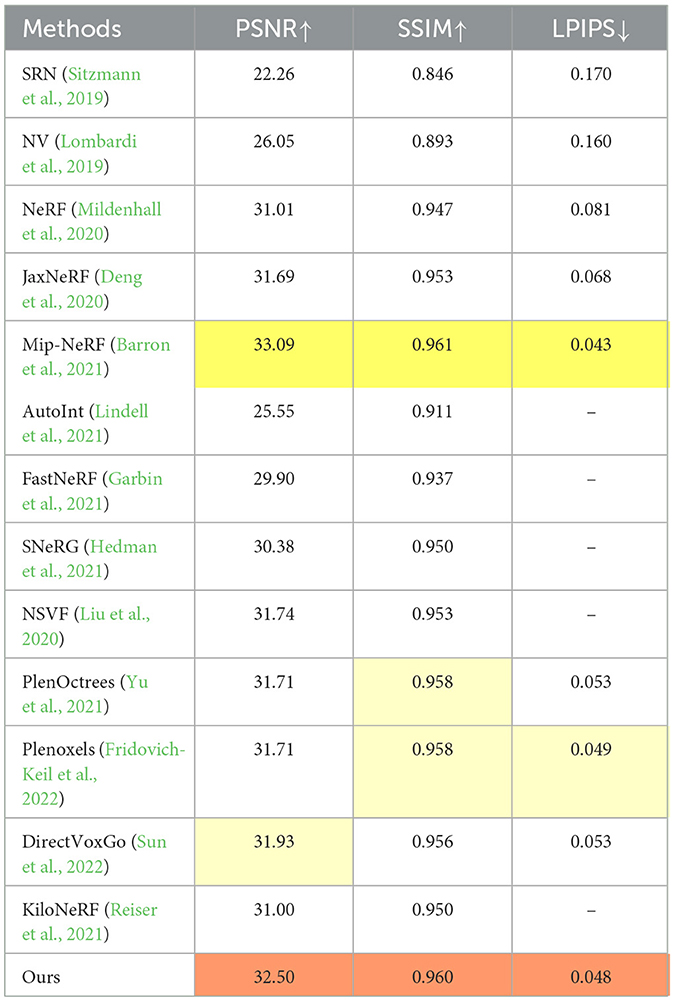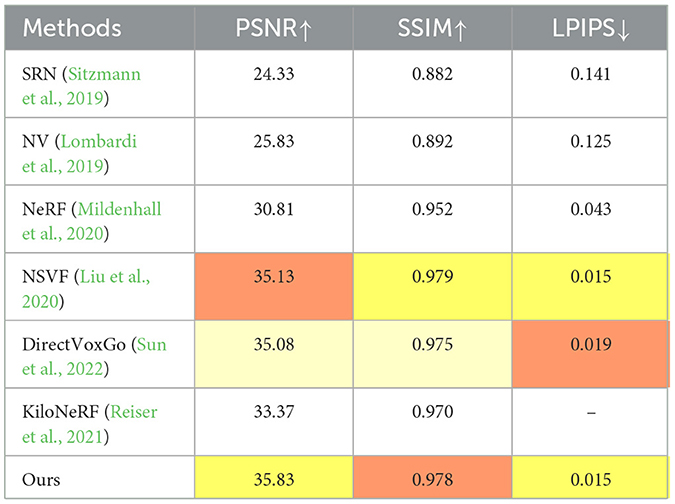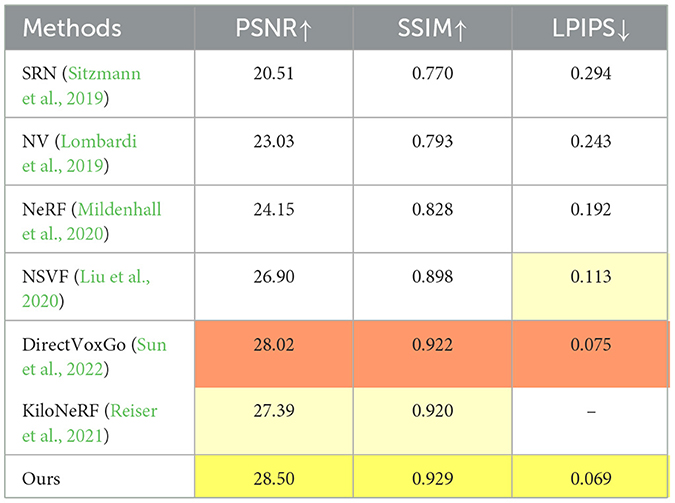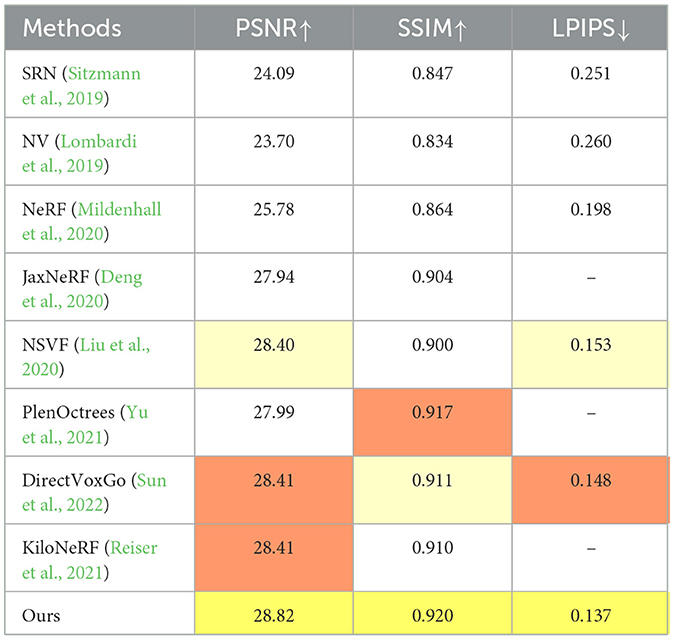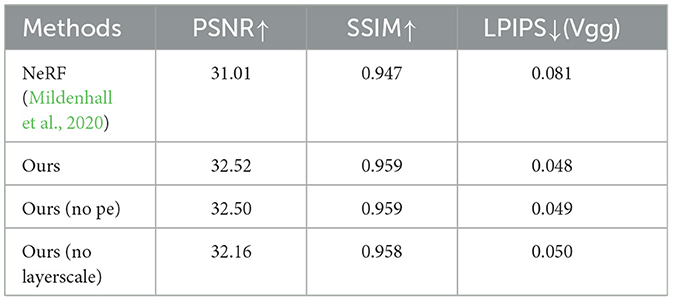- Chuzhou Polytechnic, Chuzhou, China
NeRF and its variants excel in novel view synthesis but struggle with scenes featuring specular highlights. To address this limitation, we introduce the Highlight Recovery Network (HRNet), a new architecture that enhances NeRF's ability to capture specular scenes. HRNet incorporates Swish activation functions, affine transformations, multilayer perceptrons (MLPs), and residual blocks, which collectively enable smooth non-linear transformations, adaptive feature scaling, and hierarchical feature extraction. The residual connections help mitigate the vanishing gradient problem, ensuring stable training. Despite the simplicity of HRNet's components, it achieves impressive results in recovering specular highlights. Additionally, a density voxel grid enhances model efficiency. Evaluations on four inward-facing benchmarks demonstrate that our approach outperforms NeRF and its variants, achieving a 3–5 dB PSNR improvement on each dataset while accurately capturing scene details. Furthermore, our method effectively preserves image details without requiring positional encoding, rendering a single scene in ~18 min on an NVIDIA RTX 3090 Ti GPU.
1 Introduction
Novel view synthesis has been a persistent challenge in computer vision and graphics. Utilizing deep learning to interpret 3D scenes from sparse image sets has wide-ranging applications in entertainment, virtual and augmented reality, and other fields. Emerging neural rendering techniques have recently enabled photorealistic image quality for these tasks. One of the most prominent recent advances in neural rendering is NeRF (Mildenhall et al., 2020) which, given a handful of images of a static scene, learns an implicit volumetric representation of the scene that can be rendered from novel viewpoints. Although the current neural rendering technology has achieved leading image rendering quality, it still does not perform well in terms of model acceleration and image specular reflections detail. By sampling the 3D coordinates in the scene, and using the MLP to infer the density of the location and the view-dependent color value, NeRF renders compelling photorealistic images of 3D scenes from novel viewpoints using a neural volumetric scene representation. Volumetric neural rendering incurs a significant computational burden due to stringent sampling requirements and the high cost of neural network queries, leading to substantially prolonged processing times. To address this limitation, we adopt the dense voxel grid linear interpolation strategy proposed by Sun et al. (2022) to generate the scene's density and view-dependent color features.
Although NeRF employs positional encoding that maps the inputs to a higher dimensional space using high-frequency functions to improve renderings that perform poorly at representing high-frequency variation in color and geometry, it still renders poorly on specular surfaces. Figure 1 shows that NeRF and its variants rendering quality is still not ideal on specular objects. The rendering results for the drums category appear notably rough. These rough artifacts are main caused by spectral bias (Rahaman et al., 2019). Variants (Müller et al., 2022; Rosu and Behnke, 2023; Garbin et al., 2021; Hedman et al., 2021; Lindell et al., 2021; Liu et al., 2020; Rebain et al., 2021; Schwarz et al., 2020; Yu et al., 2021) of NeRF work well in the direction of acceleration, but there is little work that combines acceleration with image quality, especially for scene highlight details. A deeper MLP with ReLU activation is used to implicitly represent the 3D scene. Additionally, position encoding (Rahaman et al., 2019) is applied to the sampled point coordinates and viewpoint vector, mapping them to a high-dimensional space and enhancing the MLP's ability to approximate high-frequency functions. This MLP+ReLU implicit representation structure has not been effectively improved in the subsequent NeRFs method, leading to a long-term limitation in the image rendering quality of NeRFs, where the model cannot effectively learn the high-frequency details of the image. To address this issue, we propose the HRNet architecture, which can be combined with a learnable 3D grid to significantly enhance image rendering quality and achieve satisfactory model training speed. The MLP architecture employed by NeRFs (Mildenhall et al., 2020) can lead to variations in their feature vectors with depth, inconsistencies in feature space, and issues such as gradient loss and explosion. Hence, we incorporate skip connections, layer scaling, and affine layers into the traditional MLP to ensure stable training and enhance the network's capacity to model high-frequency components. Simultaneously, we utilize the Swish activation function to replace ReLU. This alteration significantly enhances the MLP's capability to capture image details. Our method overview is shown in Figure 2.
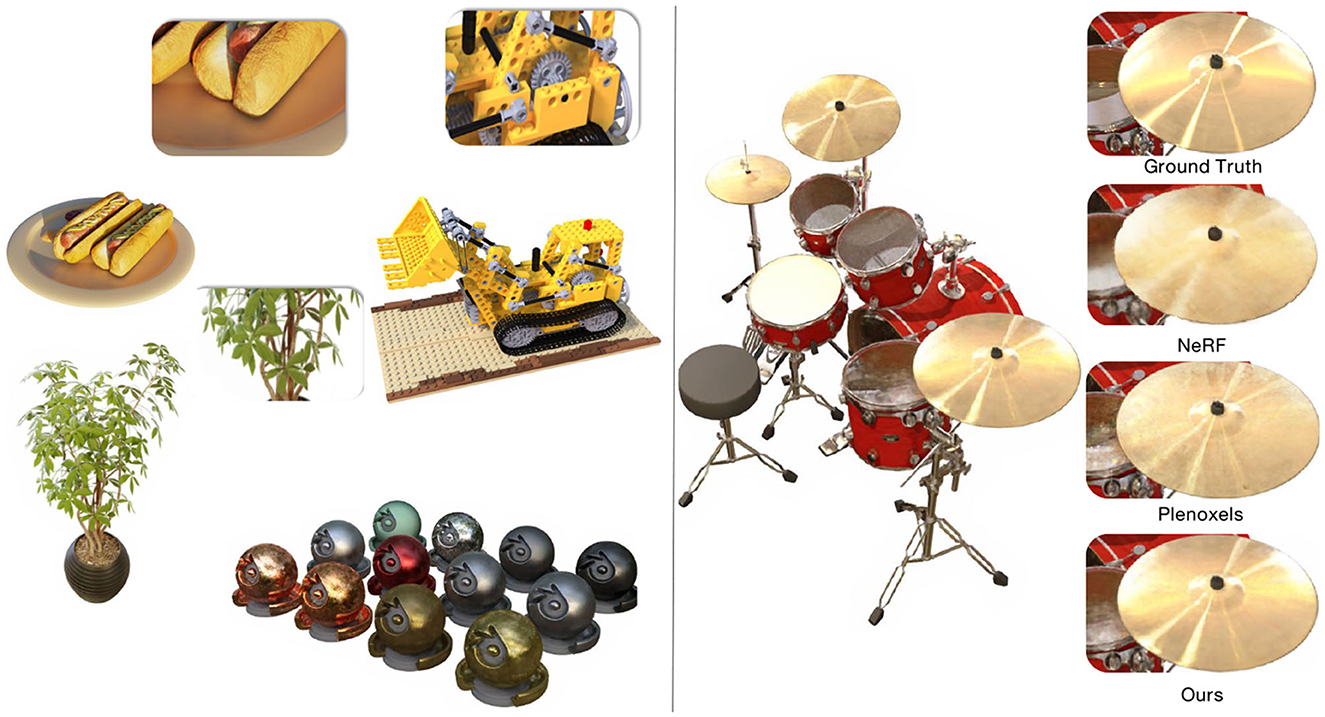
Figure 1. We present a method to represent complex signals such as specular reflections. Our method is able to match the expressiveness of coordinate-based MLPs while retaining reconstruction and rendering speed of voxel grids.
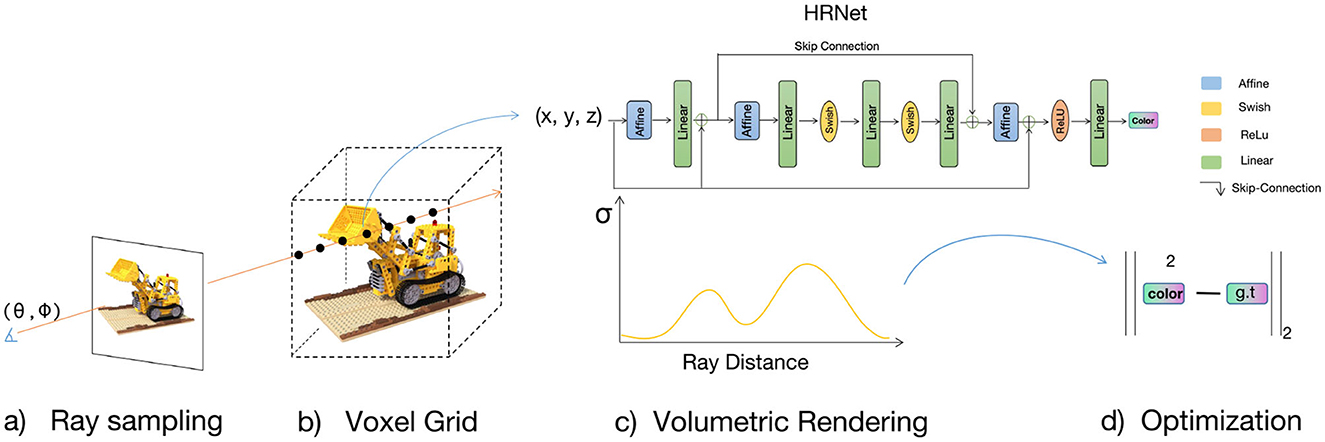
Figure 2. Method overview. The coordinates x of the ray sampling points are linearly interpolated by the learnable 3D Grid and then stitched with the viewpoint vector d. Finally, they are fed into the HRNet to predict the color values. The HRNet is stably trained and accelerates convergence using an affine transformation layer. Layerscale and Skip Connection are used to enhance the network's ability to fit high-frequency information.
To summarize, we make the following contributions:
1. We propose the Highlight Recovery Network (HRNet), an enhanced MLP that effectively renders scene image details, especially for highlight scenes.
2. We utilize explicit and discretized volumetric representations for modeling. While not a new approach, when combined with HRNet, it achieves leading rendering speed and image quality. Compared to NeRF, our method requires only about 18 min to train a single scene and improves the average PSNR by 3–5 dB.
2 Related work
2.1 Neural radiance fields
Recently, NeRF has caused a new boom in new view synthesis tasks. By simply inputting images of the sparse angles of the scene and the corresponding camera parameters, images of the new view can be obtained. Compared to traditional explicit and discrete volume representations such as voxel lattices and MPI, NeRF performs extremely well in the novel view synthesis task, using a coordinate-based MLP as an implicit and continuous volume representation. NeRF achieves appealing quality and has good flexibility with many follow-up extensions to various setups, e.g., relighting (Bi et al., 2020; Boss et al., 2021; Srinivasan et al., 2021; Zhang et al., 2021), deformation (Gafni et al., 2021; Noguchi et al., 2021; Park et al., 2020; Tretschk et al., 2021), self-calibration (Jeong et al., 2021; Lin et al., 2021; Yen-Chen et al., 2021; Meng et al., 2021; Wang et al., 2021), meta-learning (Tancik et al., 2021), dynamic scene modeling (Gao et al., 2021; Li et al., 2021; Martin-Brualla et al., 2021; Pumarola et al., 2021; Xian et al., 2021), and generative modeling (Chan et al., 2021; Kosiorek et al., 2021; Schwarz et al., 2020). However, NeRF and its variants require a lengthy training time ranging from hours to days for a single scene. Here, we introduce the derivation of the density voxel grid to accelerate the model.
2.2 Enhanced standard MLP
As a classic neural network, MLP is applied to various tasks of deep learning. Transformers (Vaswani et al., 2017) built by MLP shine in natural language processing, image classification, and recognition tasks. MLP-Mixer (Tolstikhin et al., 2021) uses Mixer's MLP to replace ViT's Transformer (Dosovitskiy et al., 2020), which reduces the degree of freedom of feature extraction and can cleverly exchange information between patches and information within patches alternately. Recently, Facebook AI Lab proposed ResMLP (Touvron et al., 2021) for tasks such as image classification, a purely MLP-based architecture that uses residual operations to update projection features, and finally average pools all block features classification later. It is more stable than Transformer training and more concise than MLP-Mixer. Inspired by ResMLP, we propose the HRNet architecture to represent neural radiance fields, which has amazing performance.
2.3 Spectral bias
Recent works (Mildenhall et al., 2020; Rahaman et al., 2019; Sitzmann et al., 2020; Tancik et al., 2020) have shown that a standard MLP with ReLU (Glorot et al., 2011) shows limited performance in representing high-frequency textures. Researchers call this phenomenon spectral bias. Its presence leads to some limitations of the coordinate-based MLP to implicitly represent 3D scenes, such as the inability to fit high-frequency details of object surfaces. Various methods have been proposed to alleviate this problem. For example, researchers have proposed the SIREN (Sitzmann et al., 2020) periodic activation function to replace the ReLU activation function, which can achieve accelerated convergence as well as improved image quality. Other approaches (Mildenhall et al., 2020; Tancik et al., 2020) are to map input coordinates into high-dimensional Fourier space by using position encoding or Fourier feature mapping before passing an MLP. This is also the scheme used by NeRFs, but we found that the images rendered by NeRFs still have problems with highlight details being difficult to capture. We consider that the ReLU activation function is still not the optimal choice, so we use the Swish (Ramachandran et al., 2017) activation function to replace ReLU, and the introduction of the skip-connection, layerscale and affine module in MLP can ensure the consistency of network features and significantly improve the network's ability to fit high-frequency details.
3 Preliminaries
To represent 3D scenes implicitly, NeRF (Mildenhall et al., 2020) employs MLP networks. Given any input 3D position x and a viewing direction d, NeRF uses a spatial MLP to output the density σ of volumetric particles and view-dependent color emission c:
MLP(post) first processes the input 3D coordinate × with eight fully-connected layers and outputs σ and a feature vector e. This feature vector e is then concatenated viewing direction d and passed to MLP(rgb) that output the view-dependent RGB color c. In practice, positional encoding γ is applied to x and d, which enables the MLPs to learn the high-frequency details from low-dimensional input (Tancik et al., 2020). The ray is projected at the pixel center of the image along the viewing direction d, and N coordinate points are sampled in a limited range. The MLP is used to query their densities and colors of these N points. Finally, the N queried results are accumulated into a single color with the volume rendering quadrature in accordance with the optical model given by Max (1995):
where δj is the distance between adjacent samples. The function Ti denotes accumulated transmittance along the ray from near and far samples. If the ray is blocked, the later sample points will not be calculated. For more accurate sampling, NeRF simultaneously optimize two networks: one “coarse” and one “fine.” Given a training image with camera pose, the NeRF model optimizes the loss value between the predicted pixel value and the true pixel value:
where Ĉc(r) and Ĉf(r) is color pixel values for the coarse and fine network outputs. C(r) is the ground truth. is the set of rays in each batch.
4 Method
In this section, similar to Sun et al. (2022), we will first introduce how to use a density voxel grid to achieve scene reconstruction. The reconstruction process is divided into two stages: a coarse stage and a fine stage. In the coarse stage, a low resolution voxel grid is used to obtain the density and color of the scene through an interpolation algorithm. Building on the coarse stage, the grid resolution is then increased to further reconstruct scene details and view-dependent colors. Next, we propose HRNet, a novel High-Resolution Residual Multi-Layer Perceptron (MLP) Network designed to effectively model high-dimensional data through a hierarchical residual architecture. HRNet leverages a combination of affine transformations, multi-layer perceptrons, and a custom Swish activation function to achieve robust feature extraction and transformation, culminating in a low-dimensional output suitable for tasks such as 3D regression or scene representation. Figure 3 illustrates the overall network structure of our method.

Figure 3. HRNet overview. The proposed High-Resolution Residual Multi-Layer Perceptron Network comprises Affine transformations, linear layers, Swish activation, and residual connections, enabling efficient feature learning.
4.1 Coarse scene reconstruction
In the coarse stage, our method aims to efficiently establish an initial representation of the geometry and density distribution of the scene. This stage employs a low-resolution voxel grid to accelerate the optimization process, prioritizing computational efficiency over fine-grained detail. The primary objective is to provide a robust foundation for subsequent refinement by capturing the overall structure and appearance of the scene. A voxel grid is used to explicitly model the volumetric density of the scene, where N(c) denotes the resolution of the coarse grid (e.g. N(c) = 64). For any 3D position x∈ℝ3, the density σ(x) is computed via trilinear interpolation:
Similarly, a separate voxel grid stores view-invariant color emissions. The color c(x) at position x is obtained as:
This stage effectively captures the coarse geometry and appearance, serving as an initialization for the fine stage while avoiding the computational overhead of high-resolution optimization from scratch.
4.2 Fine scene reconstruction
Building upon the coarse stage, the fine stage refines the representation of the scene by improving geometric details and introducing view-dependent appearance effects. The resolution of the voxel grid is increased to N(f) (e.g. N(f) = 256), enabling the method to model intricate structures and subtle variations in density and color with greater precision. The density is now represented by a higher resolution voxel grid , and the density at position x is similarly interpolated:
To account for view-dependent effects, we introduce a feature voxel grid , where F denotes the dimensionality of the feature (e.g. F = 16). The color c(x, d) is computed by combining the interpolated features with the viewing direction d through HRNet:
The HRNet maps the input features and direction to an RGB output. The output of the coarse stage is frozen or used as a priori to guide the optimization of and , thus reducing the convergence time. This two-stage approach balances efficiency and quality, achieving superior rendering precision while maintaining computational tractability.
4.3 HRNet: high-resolution residual multi-layer perceptron network
4.3.1 Swish activation function
HRNet incorporates a parameterized Swish activation function, defined as f(x) = x·σ(x), where σ(x) denotes the sigmoid function. This activation is implemented with an optional in-place operation to optimize memory usage during training. Unlike the widely-used ReLU, Swish provides a smooth, non-monotonic nonlinearity that preserves negative values, potentially enhancing gradient flow and model expressiveness.
4.3.2 Affine transformation module
A lightweight Affine module is introduced to perform per-dimension scaling and shifting of the input features. Formally, given an input x∈ℝd, the transformation is computed as y = α·x+β, where α, β∈ℝd are learnable parameters initialized to ones and zeros, respectively. This module serves as a feature normalization mechanism, akin to simplified layer normalization, enabling the network to adaptively adjust the scale and bias of intermediate representations.
4.3.3 Multi-layer perceptron (MLP) block
The MLP block in HRNet consists of a three-layer fully-connected network with an expansion-compression design. For an input dimension d, the architecture expands the feature space to 2d through the first layer, maintains this dimensionality in the second layer, and compresses it back to d in the third layer. Each linear transformation is followed by the Swish activation, facilitating non-linear feature mapping. This bottleneck-inspired design increases the network's capacity to capture complex patterns while maintaining computational efficiency.
4.3.4 Residual MLP block (ResMLP block)
At the core of HRNet lies the Residual MLP (ResMLP) Block, which integrates residual connections and a LayerScale mechanism to enhance training stability and performance in deep architectures. The block operates as follows:
- The input x is first processed by an Affine module, followed by a linear layer Linear(d, d), yielding a residual term r1.
- This residual is added to the input, and further scaled by a learnable LayerScale parameter , initialized with a small constant (e.g., 10−5).
- The resulting feature is then passed through another Affine module and the MLP block, producing a second residual term r2, which is similarly scaled by and added to the intermediate representation.
This dual-residual structure, combined with LayerScale, mitigates the vanishing gradient problem and allows the network to preserve high-resolution feature information across layers.
4.3.5 HRNet architecture
The full HRNet model consists of a stack of N ResMLP blocks, where N is a configurable depth parameter (we set N = 1 in our experiments). The input x is sequentially processed by each block, followed by a final Affine transformation and a global residual connection that adds the original input to the output of the block stack. The resulting features are activated using ReLU and mapped to a 3-dimensional output via a linear layer Linear(d, 3). This design ensures that both local and global contextual information are preserved, making HRNet particularly suited for tasks requiring precise low-dimensional predictions.
4.3.6 Design rationale and contributions
HRNet draws inspiration from residual networks and Transformer-like architectures, adapting these concepts to a fully-connected MLP framework. The use of LayerScale and multiple residual paths enables the model to scale effectively with depth, while the Swish activation and affine transformations enhance its representational flexibility. By outputting a 3-dimensional vector, HRNet is tailored for applications in 3D vision tasks, such as scene reconstruction or object localization, where maintaining high-resolution feature fidelity is critical.
5 Experiments
In this section, we highlight the advantages of our method by comparing experimental data and rendered images. We use four publicly available datasets for this comparison: Synthetic-NeRF (Mildenhall et al., 2020), Synthetic-NSVF (Liu et al., 2020), BlendedMVS (Yao et al., 2020), and Tanks&Temples (Knapitsch et al., 2017). We will first introduce each dataset, followed by images rendered using our method. Next, we present the comparison results using standard metrics from previous view synthesis studies: PSNR, SSIM (Wang et al., 2004), and LPIPS (Zhang et al., 2018). Note that golden yellow indicates first place, orange indicates second, and light yellow indicates third.
5.1 Synthetic scenes
5.1.1 Synthetic-NeRF
The Synthetic-NeRF dataset, from the original NeRF paper, features path-traced renderings of geometrically complex objects with non-Lambertian materials across eight scenes (chair, drums, ficus, hotdog, lego, materials, mic, ship). Each scene includes 100 training, 100 validation, and 200 test images at 800 × 800 resolution in RGBA format. We conducted comprehensive experiments on this public dataset, comparing 13 leading methods, including DirectVoxGo, Plenoxels, PlenOctrees, Mip-NeRF, and NSVF, for image rendering quality. Table 1 highlights our method's superior performance in PSNR, SSIM, and LPIPS metrics. While Mip-NeRF excels in quality, it requires 6 h to train on an RTX 2080Ti GPU. Figure 4 compares our method against state-of-the-art approaches, showing zoomed-in renderings from eight scenes. Our method produces sharper, more detailed images with fewer artifacts, closely resembling ground truth.
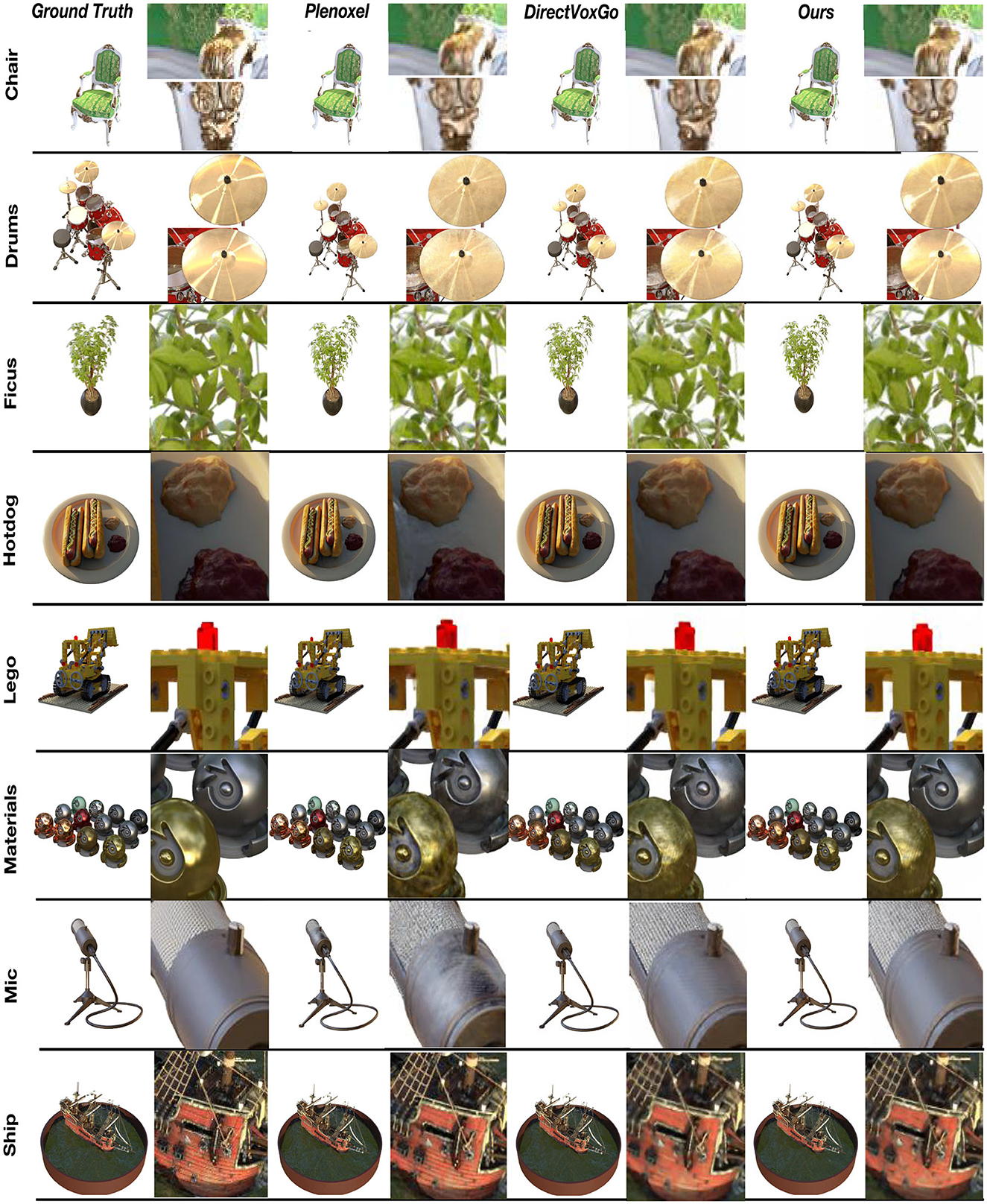
Figure 4. Quantitative results on the synthetic-NeRF test scenes. We selected three categories of rendered images from Synthetic-NeRF: Hotdog, Mic, and Materials to compare with Plenoxels and DirectVoxGo. We can find that the images rendered by Plenoxels and DirectVoxGo are not smooth enough, and the blue box dotted area in the figure.
5.1.2 Synthetic-NSVF
The Synthetic-NSVF dataset includes eight diverse objects (Wineholder, Steamtrain, Toad, Robot, Bike, Palace, Spaceship, Lifestyle), each with 100 training and 200 test images at 800 × 800 resolution. Its complex geometries and textures challenge rendering methods. As shown in Table 2, our method ranks first in PSNR (35.83) and LPIPS (0.015), nearly matching NSVF's top SSIM (0.979 vs. 0.978), and outperforms DirectVoxGo by 0.8 dB in PSNR. This demonstrates our approach's superior quality, fidelity, and artifact reduction in synthetic scene rendering.
5.1.3 BlendedMVS and Tanks & Temples
These datasets, characterized by real-world complexity such as intricate textures, varied lighting, and complex geometries, are established benchmarks for assessing image rendering in photogrammetry and 3D reconstruction. Our method outperforms on BlendedMVS and Tanks & Temples datasets (Tables 3, 4), improving PSNR by 4 dB and 3 dB, respectively, against NeRF baselines using public real-world data. This reflects our approach's strength in capturing fine details and handling diverse, challenging scenes—including reflective surfaces, shadows, and occlusions—enhancing rendering fidelity across varied datasets.
5.2 Ablation study
We study the impact of the different components of HRNet in ablation studies. We mainly validate the effectiveness of layerscale, skip-connection and swish —which enable standard MLP to model scene appearance with NeRF better quality. At the same time, verify the validity of the case without position encoding. Table 5 shows that our HRNet still renders images of high quality even without positional encoding. When we remove the some module, the evaluation metrics drop significantly, which fully demonstrates the effectiveness of this module.
6 Conclusion
Our method strikes a balance between rendering quality and speed in neural radiance fields, surpassing both the original NeRF and most of its variants in terms of rendering quality and training efficiency. As noted in the introduction, our approach trains a single scene in ~18 min, with a PSNR improvement of 3–5 dB over the original NeRF. However, it still falls short of achieving real-time rendering and shows some flaws in quality at higher resolutions. Despite these limitations, we believe our method lays the groundwork for faster convergence and enhanced rendering quality in such scenarios. We expect that our approach will contribute to further advancements in NeRF-based scene reconstruction and its applications.
Data availability statement
The original contributions presented in the study are included in the article/supplementary material, further inquiries can be directed to the corresponding author.
Author contributions
SD: Conceptualization, Data curation, Validation, Writing – original draft, Writing – review & editing. SW: Writing – review & editing.
Funding
The author(s) declare that financial support was received for the research and/or publication of this article. This work was supported by Anhui Provincial Quality Engineering Project for Higher Education Institutions (2022jnds043), Chuzhou Polytechnic Campus Science and Technology Innovation Platform Project (YJP-2023-02), Anhui Provincial Natural Science Research Project for Higher Education Institutions (2023AH053088, 2022AH040332), Chuzhou Polytechnic Campus Research Project (ZKZ-2022-02), Anhui Province Quality Improvement and Talent Cultivation Project (2022TZPY040), Anhui Province Mid-Career and Young Teachers Training Initiative - Outstanding Young Teacher Cultivation Project (YQYB2023163), the 2024 Anhui Provincial University Natural Science Research Key Project “Research on Key Technologies of Intelligent Identification and Classified Delivery System for Domestic Waste” (2024AH051439), and the 2024 Teacher Industry and Enterprise On-the-Job Practice Plan Project (xjgz2024009).
Conflict of interest
The authors declare that the research was conducted in the absence of any commercial or financial relationships that could be construed as a potential conflict of interest.
Generative AI statement
The author(s) declare that no Gen AI was used in the creation of this manuscript.
Publisher's note
All claims expressed in this article are solely those of the authors and do not necessarily represent those of their affiliated organizations, or those of the publisher, the editors and the reviewers. Any product that may be evaluated in this article, or claim that may be made by its manufacturer, is not guaranteed or endorsed by the publisher.
References
Barron, J. T., Mildenhall, B., Tancik, M., Hedman, P., Martin-Brualla, R., and Srinivasan, P. P. (2021). “Mip-nerf: a multiscale representation for anti-aliasing neural radiance fields,” in Proceedings of the IEEE/CVF International Conference on Computer Vision (Piscataway, NJ: IEEE), 5855–5864. doi: 10.1109/ICCV48922.2021.00580
Bi, S., Xu, Z., Srinivasan, P., Mildenhall, B., Sunkavalli, K., Hašan, M., et al. (2020). Neural reflectance fields for appearance acquisition. arXiv preprint arXiv:2008.03824.
Boss, M., Braun, R., Jampani, V., Barron, J. T., Liu, C., and Lensch, H. (2021). “Nerd: neural reflectance decomposition from image collections,” in Proceedings of the IEEE/CVF International Conference on Computer Vision (Piscataway, NJ: IEEE), 12684–12694. doi: 10.1109/ICCV48922.2021.01245
Chan, E. R., Monteiro, M., Kellnhofer, P., Wu, J., and Wetzstein, G. (2021). “Pi-gan: periodic implicit generative adversarial networks for 3d-aware image synthesis,” in Proceedings of the IEEE/CVF Conference on Computer Vision and Pattern Recognition (Piscataway, NJ: IEEE), 5799–5809. doi: 10.1109/CVPR46437.2021.00574
Deng, B., Barron, J. T., and Srinivasan, P. P. (2020). Jaxnerf: An Efficient Jax Implementation of Nerf . Available online at: http://github.com/google-research/google-research/tree/master/jaxnerf (accessed November 2, 2024).
Dosovitskiy, A., Beyer, L., Kolesnikov, A., Weissenborn, D., Zhai, X., Unterthiner, T., et al. (2020). An image is worth 16x16 words: transformers for image recognition at scale. arXiv preprint arXiv:2010.11929.
Fridovich-Keil, S., Yu, A., Tancik, M., Chen, Q., Recht, B., and Kanazawa, A. (2022). “Plenoxels: radiance fields without neural networks,” in Proceedings of the IEEE/CVF Conference on Computer Vision and Pattern Recognition (Piscataway, NJ: IEEE), 5501–5510. doi: 10.1109/CVPR52688.2022.00542
Gafni, G., Thies, J., Zollhofer, M., and Nießsner, M. (2021). “Dynamic neural radiance fields for monocular 4d facial avatar reconstruction,” in Proceedings of the IEEE/CVF Conference on Computer Vision and Pattern Recognition (Piscataway, NJ: IEEE), 8649–8658. doi: 10.1109/CVPR46437.2021.00854
Gao, C., Saraf, A., Kopf, J., and Huang, J.-B. (2021). “Dynamic view synthesis from dynamic monocular video,” in Proceedings of the IEEE/CVF International Conference on Computer Vision (Piscataway, NJ: IEEE), 5712–5721. doi: 10.1109/ICCV48922.2021.00566
Garbin, S. J., Kowalski, M., Johnson, M., Shotton, J., and Valentin, J. (2021). “Fastnerf: high-fidelity neural rendering at 200fps,” in Proceedings of the IEEE/CVF International Conference on Computer Vision, 14346–14355. doi: 10.1109/ICCV48922.2021.01408
Glorot, X., Bordes, A., and Bengio, Y. (2011). “Deep sparse rectifier neural networks,” in Proceedings of the Fourteenth International Conference on Artificial Intelligence and Statistics, JMLR Workshop and Conference Proceedings, 315–323.
Hedman, P., Srinivasan, P. P., Mildenhall, B., Barron, J. T., and Debevec, P. (2021). “Baking neural radiance fields for real-time view synthesis,” in Proceedings of the IEEE/CVF International Conference on Computer Vision (Piscataway, NJ: IEEE), 5875–5884. doi: 10.1109/ICCV48922.2021.00582
Jeong, Y., Ahn, S., Choy, C., Anandkumar, A., Cho, M., and Park, J. (2021). “Self-calibrating neural radiance fields,” in Proceedings of the IEEE/CVF International Conference on Computer Vision (Piscataway, NJ: IEEE), 5846–5854. doi: 10.1109/ICCV48922.2021.00579
Knapitsch, A., Park, J., Zhou, Q.-Y., and Koltun, V. (2017). Tanks and temples: benchmarking large-scale scene reconstruction. ACM Trans. Graph. 36, 1–13. doi: 10.1145/3072959.3073599
Kosiorek, A. R., Strathmann, H., Zoran, D., Moreno, P., Schneider, R., Mokrá, S., et al. (2021). “Nerf-vae: a geometry aware 3d scene generative model,” in International Conference on Machine Learning (PMLR), 5742–5752.
Li, Z., Niklaus, S., Snavely, N., and Wang, O. (2021). “Neural scene flow fields for space-time view synthesis of dynamic scenes,” in Proceedings of the IEEE/CVF Conference on Computer Vision and Pattern Recognition, 6498–6508. doi: 10.1109/CVPR46437.2021.00643
Lin, C.-H., Ma, W.-C., Torralba, A., and Lucey, S. (2021). “Barf: bundle-adjusting neural radiance fields,” in Proceedings of the IEEE/CVF International Conference on Computer Vision, 5741–5751. doi: 10.1109/ICCV48922.2021.00569
Lindell, D. B., Martel, J. N., and Wetzstein, G. (2021). “Autoint: automatic integration for fast neural volume rendering,” in Proceedings of the IEEE/CVF Conference on Computer Vision and Pattern Recognition, 14556–14565. doi: 10.1109/CVPR46437.2021.01432
Liu, L., Gu, J., Zaw Lin, K., Chua, T.-S., and Theobalt, C. (2020). Neural sparse voxel fields. Adv. Neural Inf. Process. Syst. 33:15651–15663.
Lombardi, S., Simon, T., Saragih, J., Schwartz, G., Lehrmann, A., and Sheikh, Y. (2019). Neural volumes: learning dynamic renderable volumes from images. ACM Trans. Graph. 38, 1–14. doi: 10.1145/3306346.3323020
Martin-Brualla, R., Radwan, N., Sajjadi, M. S., Barron, J. T., Dosovitskiy, A., and Duckworth, D. (2021). “Nerf in the wild: neural radiance fields for unconstrained photo collections,” in Proceedings of the IEEE/CVF Conference on Computer Vision and Pattern Recognition (Piscataway, NJ: IEEE), 7210–7219. doi: 10.1109/CVPR46437.2021.00713
Max, N. (1995). Optical models for direct volume rendering. IEEE Trans. Vis. Comput. Graph. 1, 99–108. doi: 10.1109/2945.468400
Meng, Q., Chen, A., Luo, H., Wu, M., Su, H., Xu, L., et al. (2021). “Gnerf: gan-based neural radiance field without posed camera,” in Proceedings of the IEEE/CVF International Conference on Computer Vision, 6351–6361. doi: 10.1109/ICCV48922.2021.00629
Mildenhall, B., Srinivasan, P. P., Tancik, M., Barron, J. T., Ramamoorthi, R., and Ng, R. (2020). “Nerf: representing scenes as neural radiance fields for view synthesis,” in European Conference on Computer Vision (Springer: New York), 405–421. doi: 10.1007/978-3-030-58452-8_24
Müller, T., Evans, A., Schied, C., and Keller, A. (2022). Instant neural graphics primitives with a multiresolution hash encoding. ACM Trans. Graph 41, 1–15. doi: 10.1145/3528223.3530127
Noguchi, A., Sun, X., Lin, S., and Harada, T. (2021). “Neural articulated radiance field,” in Proceedings of the IEEE/CVF International Conference on Computer Vision (Piscataway, NJ: IEEE), 5762–5772. doi: 10.1109/ICCV48922.2021.00571
Park, K., Sinha, U., Barron, J. T., Bouaziz, S., Goldman, D. B., Seitz, S. M., et al. (2020). Deformable Neural Radiance Fields (Piscataway, NJ: IEEE). doi: 10.1109/ICCV48922.2021.00581
Pumarola, A., Corona, E., Pons-Moll, G., and Moreno-Noguer, F. (2021). “D-nerf: Neural radiance fields for dynamic scenes,” in Proceedings of the IEEE/CVF Conference on Computer Vision and Pattern Recognition (Piscataway, NJ: IEEE), 10318–10327. doi: 10.1109/CVPR46437.2021.01018
Rahaman, N., Baratin, A., Arpit, D., Draxler, F., Lin, M., Hamprecht, F., et al. (2019). “On the spectral bias of neural networks,” in International Conference on Machine Learning (PMLR), 5301–5310.
Ramachandran, P., Zoph, B., and Le, Q. V. (2017). Searching for activation functions. arXiv preprint arXiv:1710.05941.
Rebain, D., Jiang, W., Yazdani, S., Li, K., Yi, K. M., and Tagliasacchi, A. (2021). “Derf: Decomposed radiance fields,” in Proceedings of the IEEE/CVF Conference on Computer Vision and Pattern Recognition (Piscataway, NJ: IEEE), 14153–14161. doi: 10.1109/CVPR46437.2021.01393
Reiser, C., Peng, S., Liao, Y., and Geiger, A. (2021). “Kilonerf: speeding up neural radiance fields with thousands of tiny mlps,” in Proceedings of the IEEE/CVF International Conference on Computer Vision (Piscataway, NJ: IEEE), 14335–14345. doi: 10.1109/ICCV48922.2021.01407
Rosu, R. A., and Behnke, S. (2023). “Permutosdf: Fast multi-view reconstruction with implicit surfaces using permutohedral lattices,” in Proceedings of the IEEE/CVF Conference on Computer Vision and Pattern Recognition (Piscataway, NJ: IEEE), 8466–8475. doi: 10.1109/CVPR52729.2023.00818
Schwarz, K., Liao, Y., Niemeyer, M., and Geiger, A. (2020). Graf: generative radiance fields for 3d-aware image synthesis. Adv. Neural Inf. Process. Syst. 33:20154–20166.
Sitzmann, V., Martel, J., Bergman, A., Lindell, D., and Wetzstein, G. (2020). Implicit neural representations with periodic activation functions. Adv. Neural Inf. Process. Syst 33, 7462–7473.
Sitzmann, V., Zollhöfer, M., and Wetzstein, G. (2019). Scene representation networks: Continuous 3d-structure-aware neural scene representations. Adv. Neural Inf. Process. Syst. 32, 600–612.
Srinivasan, P. P., Deng, B., Zhang, X., Tancik, M., Mildenhall, B., and Barron, J. T. (2021). “Nerv: neural reflectance and visibility fields for relighting and view synthesis,” in Proceedings of the IEEE/CVF Conference on Computer Vision and Pattern Recognition (Piscataway, NJ: IEEE), 7495–7504. doi: 10.1109/CVPR46437.2021.00741
Sun, C., Sun, M., and Chen, H.-T. (2022). “Direct voxel grid optimization: super-fast convergence for radiance fields reconstruction,” in Proceedings of the IEEE/CVF Conference on Computer Vision and Pattern Recognition (Piscataway, NJ: IEEE), 5459–5469. doi: 10.1109/CVPR52688.2022.00538
Tancik, M., Mildenhall, B., Wang, T., Schmidt, D., Srinivasan, P. P., Barron, J. T., et al. (2021). “Learned initializations for optimizing coordinate-based neural representations,” in Proceedings of the IEEE/CVF Conference on Computer Vision and Pattern Recognition (Piscataway, NJ: IEEE), 2846–2855. doi: 10.1109/CVPR46437.2021.00287
Tancik, M., Srinivasan, P., Mildenhall, B., Fridovich-Keil, S., Raghavan, N., Singhal, U., et al. (2020). Fourier features let networks learn high frequency functions in low dimensional domains. Adv. Neural Inf. Process. Syst. 33:7537–7547.
Tolstikhin, I. O., Houlsby, N., Kolesnikov, A., Beyer, L., Zhai, X., Unterthiner, T., et al. (2021). Mlp-mixer: An all-mlp architecture for vision. Adv. Neural Inf. Process. Syst. 34:24261–24272.
Touvron, H., Bojanowski, P., Caron, M., Cord, M., El-Nouby, A., Grave, E., et al. (2021). Resmlp: Feedforward networks for image classification with data-efficient training. arXiv preprint arXiv:2105.03404.
Tretschk, E., Tewari, A., Golyanik, V., Zollhöfer, M., Lassner, C., and Theobalt, C. (2021). “Non-rigid neural radiance fields: Reconstruction and novel view synthesis of a dynamic scene from monocular video,” in Proceedings of the IEEE/CVF International Conference on Computer Vision, 12959–12970. doi: 10.1109/ICCV48922.2021.01272
Vaswani, A., Shazeer, N., Parmar, N., Uszkoreit, J., Jones, L., Gomez, A. N., et al. (2017). Attention is all you need. Adv. Neural Inf. Process. Syst. 30.
Wang, Z., Bovik, A. C., Sheikh, H. R., and Simoncelli, E. P. (2004). Image quality assessment: from error visibility to structural similarity. IEEE Trans. Image Process. 13, 600–612. doi: 10.1109/TIP.2003.819861
Wang, Z., Wu, S., Xie, W., Chen, M., and Prisacariu, V. A. (2021). Nerf-: neural radiance fields without known camera parameters. arXiv preprint arXiv:2102.07064.
Xian, W., Huang, J.-B., Kopf, J., and Kim, C. (2021). “Space-time neural irradiance fields for free-viewpoint video,” in Proceedings of the IEEE/CVF Conference on Computer Vision and Pattern Recognition (Piscataway, NJ: IEEE), 9421–9431. doi: 10.1109/CVPR46437.2021.00930
Yao, Y., Luo, Z., Li, S., Zhang, J., Ren, Y., Zhou, L., et al. (2020). “Blendedmvs: a large-scale dataset for generalized multi-view stereo networks,” in Proceedings of the IEEE/CVF Conference on Computer Vision and Pattern Recognition (Piscataway, NJ: IEEE), 1790–1799. doi: 10.1109/CVPR42600.2020.00186
Yen-Chen, L., Florence, P., Barron, J. T., Rodriguez, A., Isola, P., and Lin, T.-Y. (2021). “Inerf: inverting neural radiance fields for pose estimation,” in 2021 IEEE/RSJ International Conference on Intelligent Robots and Systems (IROS) (IEEE), 1323–1330. doi: 10.1109/IROS51168.2021.9636708
Yu, A., Li, R., Tancik, M., Li, H., Ng, R., and Kanazawa, A. (2021). “Plenoctrees for real-time rendering of neural radiance fields,” in Proceedings of the IEEE/CVF International Conference on Computer Vision (Piscataway, NJ: IEEE), 5752–5761. doi: 10.1109/ICCV48922.2021.00570
Zhang, R., Isola, P., Efros, A. A., Shechtman, E., and Wang, O. (2018). “The unreasonable effectiveness of deep features as a perceptual metric,” in Proceedings of the IEEE Conference on Computer Vision and Pattern Recognition (Piscataway, NJ: IEEE), 586–595. doi: 10.1109/CVPR.2018.00068
Keywords: scene representation, view synthesis, image-based rendering, volume rendering, 3D deep learning, spectral bias
Citation: Dai S and Wang S (2025) HR-NeRF: advancing realism and accuracy in highlight scene representation. Front. Neurorobot. 19:1558948. doi: 10.3389/fnbot.2025.1558948
Received: 11 January 2025; Accepted: 26 March 2025;
Published: 16 April 2025.
Edited by:
Xianmin Wang, Guangzhou University, ChinaCopyright © 2025 Dai and Wang. This is an open-access article distributed under the terms of the Creative Commons Attribution License (CC BY). The use, distribution or reproduction in other forums is permitted, provided the original author(s) and the copyright owner(s) are credited and that the original publication in this journal is cited, in accordance with accepted academic practice. No use, distribution or reproduction is permitted which does not comply with these terms.
*Correspondence: Shanqin Wang, d2FuZ3NoYW5xaW4yMDA1QHllYWgubmV0
 Shufan Dai
Shufan Dai Shanqin Wang
Shanqin Wang